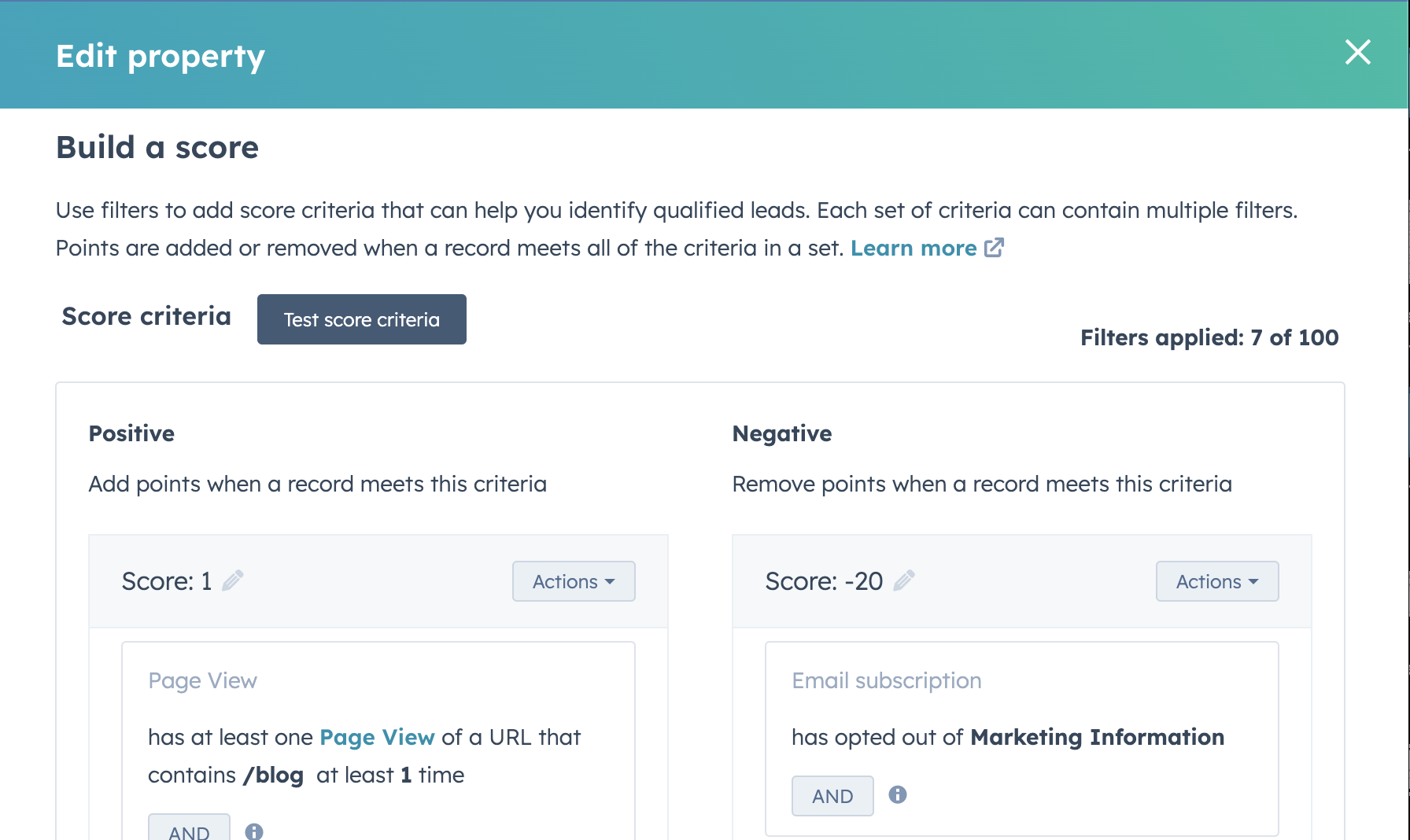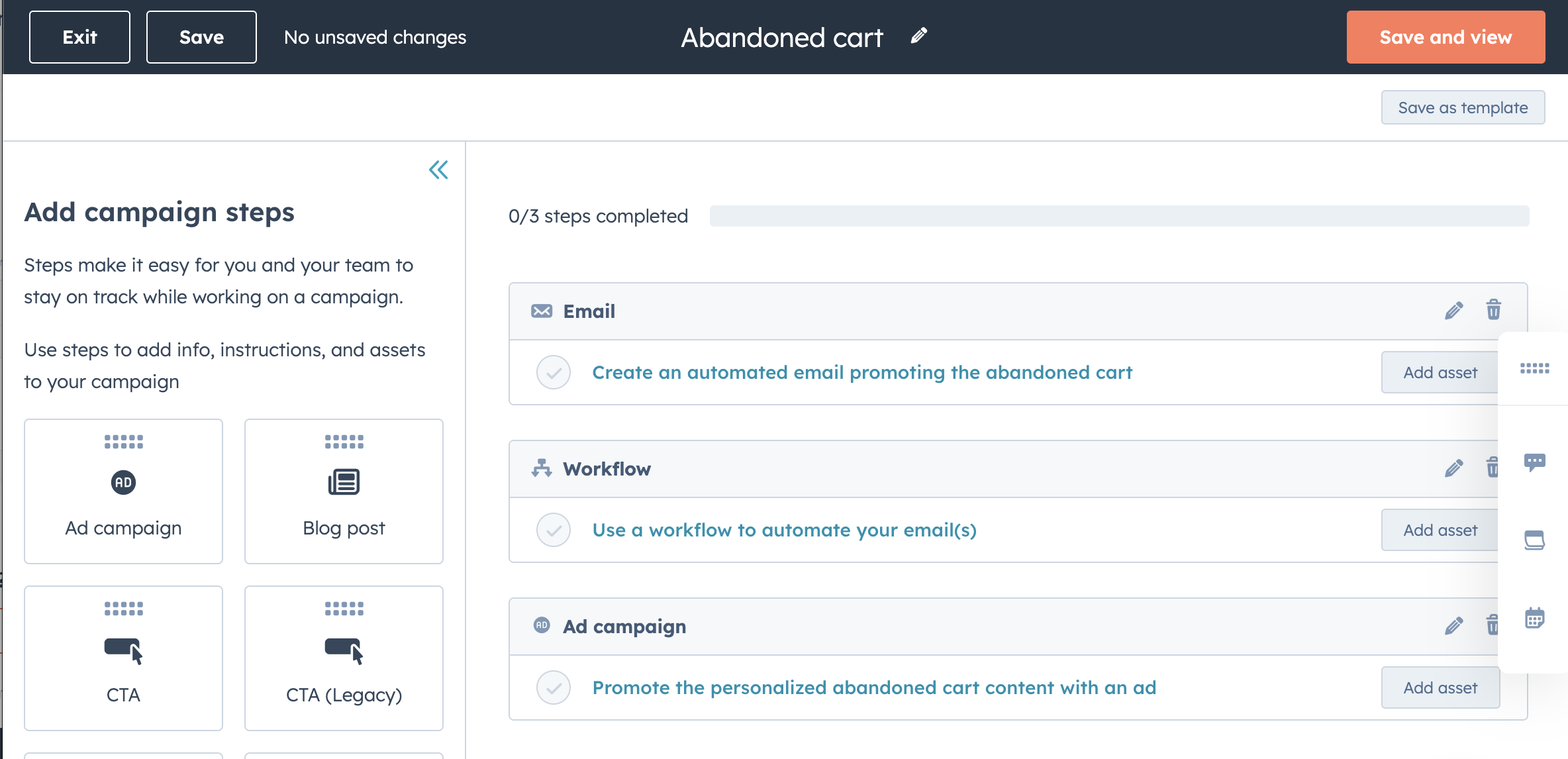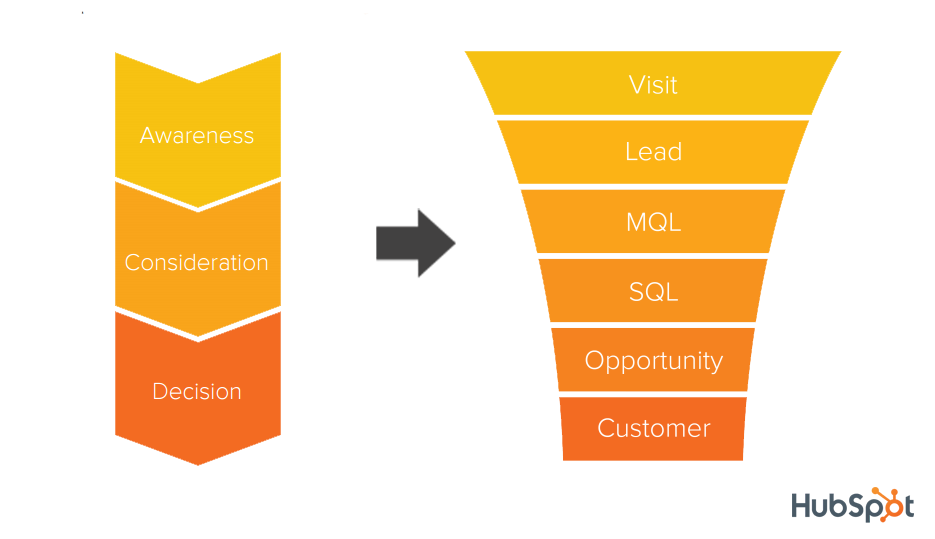Lead Scoring in HubSpot is an awesome HubSpot feature that helps your marketing and sales teams make the most of their efforts.
However, we frequently see the same misconfigurations or mistakes in HubSpot Score or Lead Scoring criteria that take away from the impact that tool can have on your business.
Watch this video to learn more about those 5 common mistakes along with how to correct them so your teams are better supported to keep crushing what they do best 💪🏻
TRANSCRIPT
Hi there, Adam Stahl, Senior HubSpot Strategist here at Remotish, here to talk to you today about lead scoring or HubSpot score, and five common mistakes or misconfigurations I commonly in portals, as well as how to correct or avoid those. To set the stage when we're talking about lead scoring and HubSpot, we're talking about a way of prioritizing essentially folks or companies for outreach.
Lead Scoring for Sales Teams
So, for example, I'm a sales rep that has an hour left in my day and I really want to get some final outreach out, but I want to make sure that with these figurative "at bats," I have the best opportunity for getting a hit. And so, for example, I want to look to Contact or Companies that are perhaps more likely to engage or to be receptive to my outreach or are more likely to be closer to ready to buy.
Lead Scoring for Marketing Teams
Or if I'm a marketing person and I'm looking to send out perhaps a promotional email, a timely one to Contacts or Companies that are closer to converting potentially to the next stage of their buyer's journey, or are closer to converting to something like an opportunity or advancing down a funnel or across the flywheel or something similar. How do I identify those folks readily, consistently and based on criteria that has been agreed upon, so that we're all focusing our efforts on the folks that are closest to converting or closest to getting to the next stage or action. That is desired to be spending our time on them first in order.
Lead Scoring Mistake #1: Overlapping Score Criteria
So with that in mind, the first thing we're going to look at is overlapping score criteria. So in lead scoring here we set our criteria and assign a score to it either positive or negative to form an aggregate HubSpot score or lead score. So what we see here is a score of one criteria for having at least one page view of a URL that contains blog at least one time. Similarly. a page view of a URL that contains blog at least three times for three points, and has at least one page view of a URL that contains blog at least five times for five points.
Now let's say as a contact I have seven page views on a URL that contains blog. What do you think the score I would be getting for that would be? *pause here for a moment* If you're answering five, the way we've actually set up this logic in here is I would be getting nine total score points, because I have viewed at least one page with blog in it, therefore I've also viewed at least three if I viewed seven and I viewed at least five at seven and so we have these overlapping score criterias.
And so that might be skewing HubSpot scores higher or lead scores higher than expected based on the logic of the criteria set forward. The way we can address this is to, and it will depend on the filter type you're using your options here, but it's to either set a top threshold or a range threshold for these. So for example, we've set thresholds here at you know at least one more than one, but no greater than three, and essentially greater than four is what this or greater than five or greater at least is what that shakes out to be.
So again depending depending on your filter type sometimes you can set a range to say if you viewed between one and three pages, or greater than six pages in this specific filter type I don't have that option, so what I would do is instead use "at most." At most viewing one page. In this case at most viewing three pages in this case. I would actually keep this one at at least five to account for anything greater than five based on the logic we have set up here. So if you view 20, hey that's awesome, but you know we've stopped our scoring threshold for giving credit for that at five. So what this would be is at we'll say i've used seven pages. Have I viewed at most one page? No I viewed it seven. Have I viewed a page with a URL at least five? Yes, score of five, that's what's expected. If I had viewed two pages, then I would get three. Which would be the intended here it's more than that one but it's not the five threshold right in the middle at that three.
Lead Scoring Mistake #2: Using Wide Scoring Ranges
So a second common misconfiguration or mistake we see with lead scoring in HubSpot is wide scoring ranges. So, for example, we see, you know, one point here, three point here, five points here, bam 60 points if you filled out a demo webinar form on any page. And you might have a scenario similar to this and you might be saying well it's super dupe like it's so important, we know that folks that have attended a webinar with us are X amount times likely to convert into customers.
That is awesome and great information to have but what I recommend then is if you have something that's that wildly important and action that you know is that key to your process or your journey, I would consider moving that instead to something like your lifecycle stages. So what that will denote is for example: maybe your leads have done a bunch of things but they haven't filled out a webinar form or attended a webinar, but then maybe you define your MQL or one of the criteria's for your marketing qualified leads is they have filled out that webinar demo form.
What that allows you to do is still denote I would say the importance of that action they filled out that webinar form, therefore they are automatically ranked higher because we have put them at a lifecycle stage higher than those that haven't. And then you can still use these properties without these giant anchors or bonuses to get that proper scoring. For example if you left this in here, and right now we have some other criteria in here like that 20 being an example of a high scoring range... there's not a lot a contact can do to ever hit that number because we put this giant pass that accelerates them to the front of the pack. But there are other more effective or efficient ways to be doing that in HubSpot like with Lifecycle Stages.
I'll note as well as a general best practice we recommend a lower score so that gives you more granularity between individuals for prioritization. It also then doesn't allow these higher weighted things to skew those numbers or give you these wild gargantuan figures as well. What I would recommend is, and I'm not saying you have to 1 and 2 or 3 but I wouldn't recommend using base 50 for this, 100 for that, or 300 for that.
What I would also recommend in that way too is that it's not necessarily there's 2 ways of doing it: to either do your scoring criteria with a tiered scoring system in mind, like a low medium and high; something low as a 1 medium is a 3 and high is a 7 or something similar. And then determine what your highest number would be based on your scoring criteria or filters and then that defines your range or save potentially. We know we want our highest score to be roughly 100. And then you can build your filter criteria and scoring to, you know, sync up to that, you know, your ideal, your highest priority buyer should have that 100, for example, or something similar.
Lead Scoring Mistake #3: Using Manual Match Criteria
Another common mistake or misconfiguration or area for opportunity, I commonly see in lead scoring is if you are using any sort of filter criteria in your lead scoring that requires a lot of individual like exact matches or multi select.
So for example, if you are a company that uses region-based criteria. So you know, maybe you prioritize North America over other regions, or if you have specific industries that you prioritize over other industries but aren't, for example, the only industries you serve. Because that would be a different criteria--that would be more qualification vs ranking. You know, you'll find if you've ever done something that's like oh, you know, let's define our North American region. You have to individually type in United States, Canada, Mexico. You probably have a sheet up on your other page of all the different countries that have to find their way into this filter. And then if you have to use it anywhere else too, you have to set it again. You have to do this every single time.
Or likewise, something like Industries in HubSpot. You have to search and check all the boxes for the applicable industries that you want to serve. What I would recommend then, is instead to use Lists to fuel this. So what I mean by that is, I would do all of this work once in an Active List.
So for example, I have a demo list here of Data Reference North American Region List, this is all of the same filter criteria as the one you see in Lead Scoring. But now because this is an Active List, I can use this in many different HubSpot tools. I can use this in my lead scoring criteria. I can use this in other lists. I can use this in filter views. I can use this in reporting, workflows. And I only ever have to do it once. And then also if something changes in this, I only have to change it in one spot.
For example, if you choose to stop serving Canada and nothing against you, Canada, I love you. But you'd have to then go to every single report where you've done filter that mentions Canada as part of North America region, every single lead score, your lead scoring, your reports, your workflows, all those other spots.
That's opposed to, if you build that one list, this criteria now looks like, and I'm just gonna clone it, it said looks like a list membership instead, so we're actually going to, delete that, we'll do and list membership is, of America. Same outcome, we want to assign three points to any Company or Contact with an associated Company or Contact in the region of, what we have defined as our North American region, which is any of, these places listed here. And that's all accounted for in this list as well, but now we can use that list, in many different places. It's a big time saver, you only have to do it once, you can use it multiple places and it makes updating your upkeep of it significantly easier as well. I'm going to come back to our big old webinar form example here.
Lead Scoring Mistake #4: Not Using Time Decay
And, that a fourth common misconfiguration or mistake I frequently see in lead scoring is not using time delay. So for example, with something like a webinar form or sorry, a webinar or an event. Or something that is fresh or timely. We maybe give them a high score for a form fill. I'm not saying you stick with your 60, but even if you were to rank that in your high threshold, which in our other here is we're calling five. Maybe we assign seven points for attending a webinar. That's probably desired. It's a desirable action. But say you have been using HubSpot since 2015. And so many years have passed and maybe they attended your first webinar in 2000. 2015 haven't done anything since or minimal things since. Maybe they were really active then in 2015 and 2016. But now, years and years and years later of dormant activity, we don't want to prioritize them over someone that attended a webinar last week and viewed five pages in the past two weeks. So how do we account for that?
So what you can do is add what I'll call like a time delay or negative criteria. So that might look something like. So we'll focus it again on this webinar. So how do we account for folks that have been to a webinar recently or maybe taking some of the beneficial edge off? Well, you know, you've been to a webinar, but maybe not recently. So there's a couple ways to do that. You can add the positive here. For they've attended webinar like in the last year or something similar, but you also probably want to sign them credit for coming to a webinar generally. So I would recommend starting with the negative here, which would be form submission. These webinar. And we'll take away, call it three points out of the, I think we called it hypothetical seven. If they have attended that webinar, but in this case, it was more than... 104 weeks ago would be two years.
We think it's still notable that you have been to a webinar and it is notable that you've been to a webinar. And so we still want to give you some score for that, but, if it's been over two years since the last time you come to a webinar. We either want to take some of the benefit off the top or we want to put some degree of time decay on it. And again, there's a couple different ways of doing it. The one that's more of it straightforward for keeping things fresh would just be adding negative criteria. So when I see is usually least utilized a lot of times folks have a ton of positive criteria and then no negative criteria. So there's just more wiggle room in there as well. And it keeps it locked to a single point. Again, a couple different ways you can look at that and there might be more specifics that are more tailored specifically to your use case, but again, this is just kind of like a high level. If you're seeing this, at least have this to be keeping that time date range in check.
Lead Scoring Mistake #5: Not Displaying the Score
And the final thing I frequently see as a mistake with lead scoring is you've done all the work to get your filters right, you've built this all out, you've had the interviews, you've talked with all the right subject matter experts and the folks that are going to be using this. And then, It's not showing anywhere. You know, a sales rep where someone comes to a contact or company record and well where's that lead score.
And so a recommendation here is to always be making sure, you know, if you are using lead score or HubSpot score, to make sure that property is showing above the fold here. Again, this will depend on what your default or your team-specific custom record views are, but make sure it's visible. You know, after, if it's not one of your super duper highest priorities property, I would make sure it's at least above the fold. So when you show up here, you can immediately see, you know, this person's either score is x, y, or z. And so I know that they are ranked in this way.
I would pair that also next to something like lifecycles stages, so you can pair those two together. You know, Adam Stahl here might be a evangelist with a HubSpot score of 43. Or, you know, someone else might be a marketing qualified lead with a HubSpot score of 31. And then you might have a lead with a HubSpot score of 29. You're gonna say, you know what? If I'm going to spend some time today, I'm probably going to be focusing on the marketing qualified lead at 31.
There are other places you can see this, but make sure it's in your Object views, like in Contacts or Companies, make sure you have a column selected for the HubSpot score. That's, I would say before scroll. I don't know if above the fold applies there when your horizontal scrolling, but make sure it's readily visible and highly recommend also making. So, you customize your records so that it's showing above the fold as well.
If you have a spot level that allows you to customize based on team, make sure your teams are configured properly and users and make sure the correct teams. So, you have that lead score above the fold, but once that will be referencing them.
So, there are five common mistakes from misconfigurations I commonly see in HubSpot portals for lead scoring and HubSpot score and how you can remedy or, adjust them to make the most of your lead scoring efforts and be doing great work or even greater work in HubSpot. Have a great rest of your day and happy lead scoring!







